Abstract
Twenty two patients over the age of 40 with stable spinal cord damage underwent overnight sleep studies to investigate the prevalence of sleep apnoea. Ten patients had some evidence of obstructive sleep apnoea (OSA). Hypoxic events were scored as number of dips of SaO2 more than 4% below the preceding 10 minute average (> 4% SaO2 dip rate). All the patients had more than five such dips per hour and six had clearly abnormal dip rates of more than 15 per hour. Two other patients had dip rates above 10 per hour without apnoeas but periods of central hypoventilation mainly during rapid eye movement (REM) sleep. OSA appears to be more common in older patients with spinal cord injury than in the general population. Possible relevant factors include patient selection, reduced ventilatory function secondary to spinal cord damage, sleep posture and medication.
Full text
PDF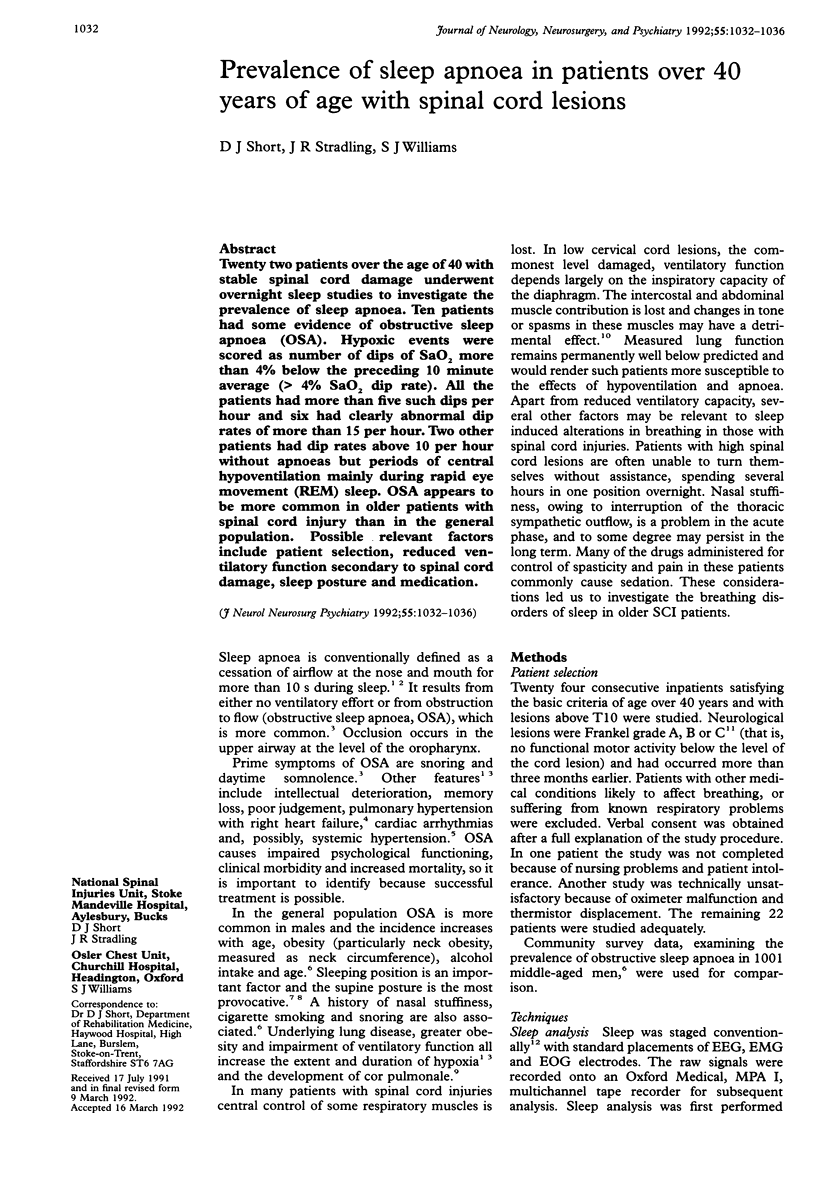
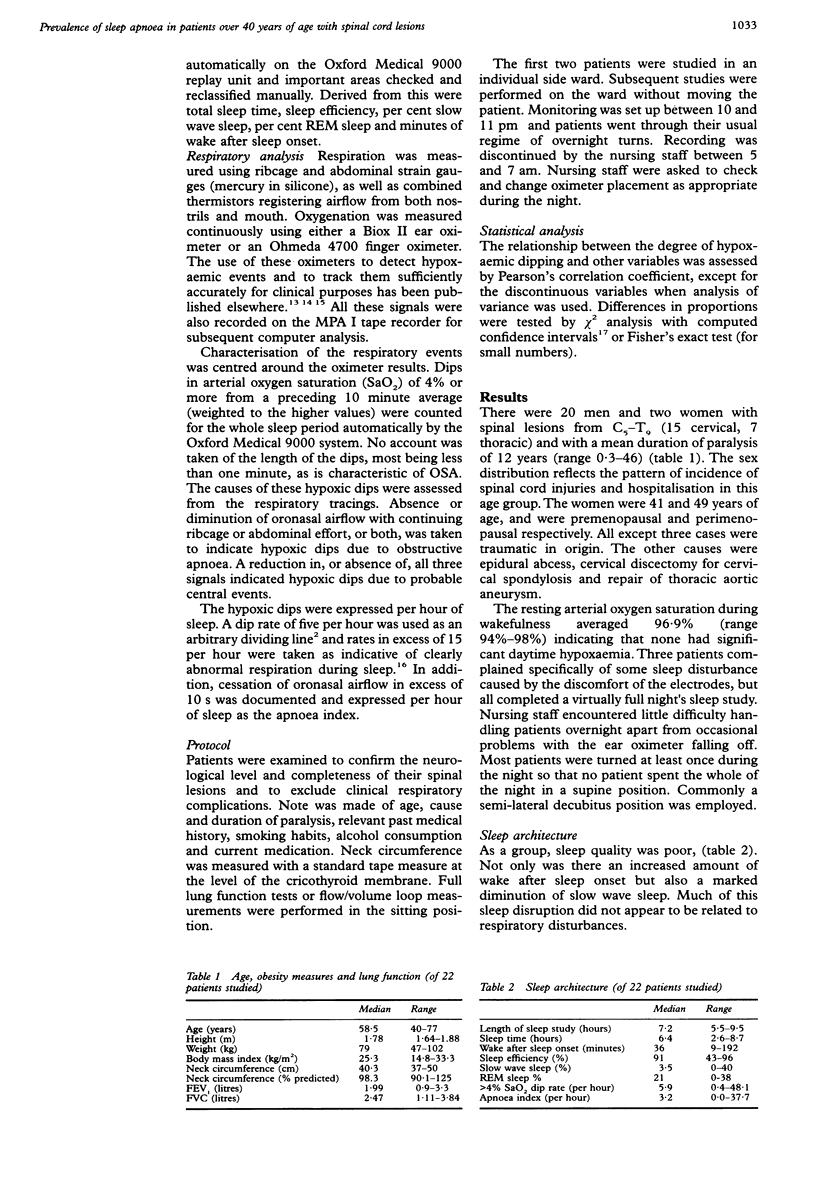
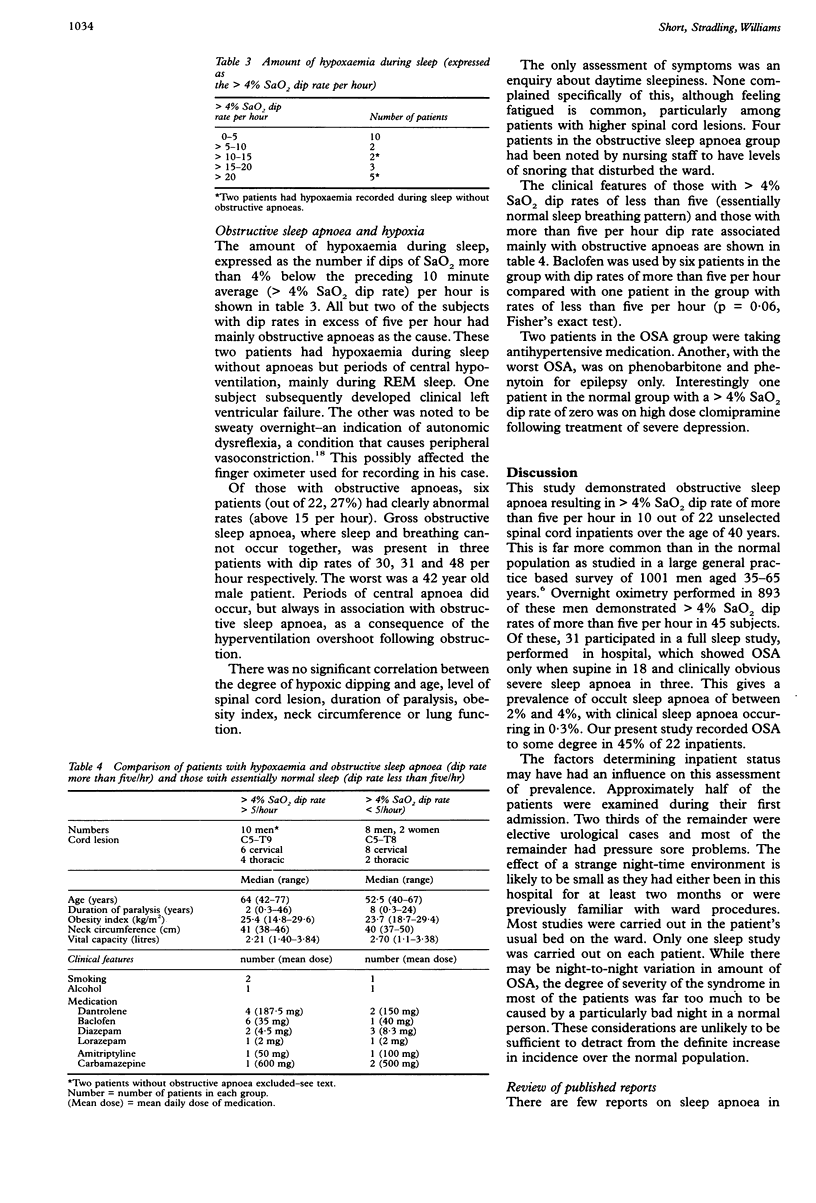
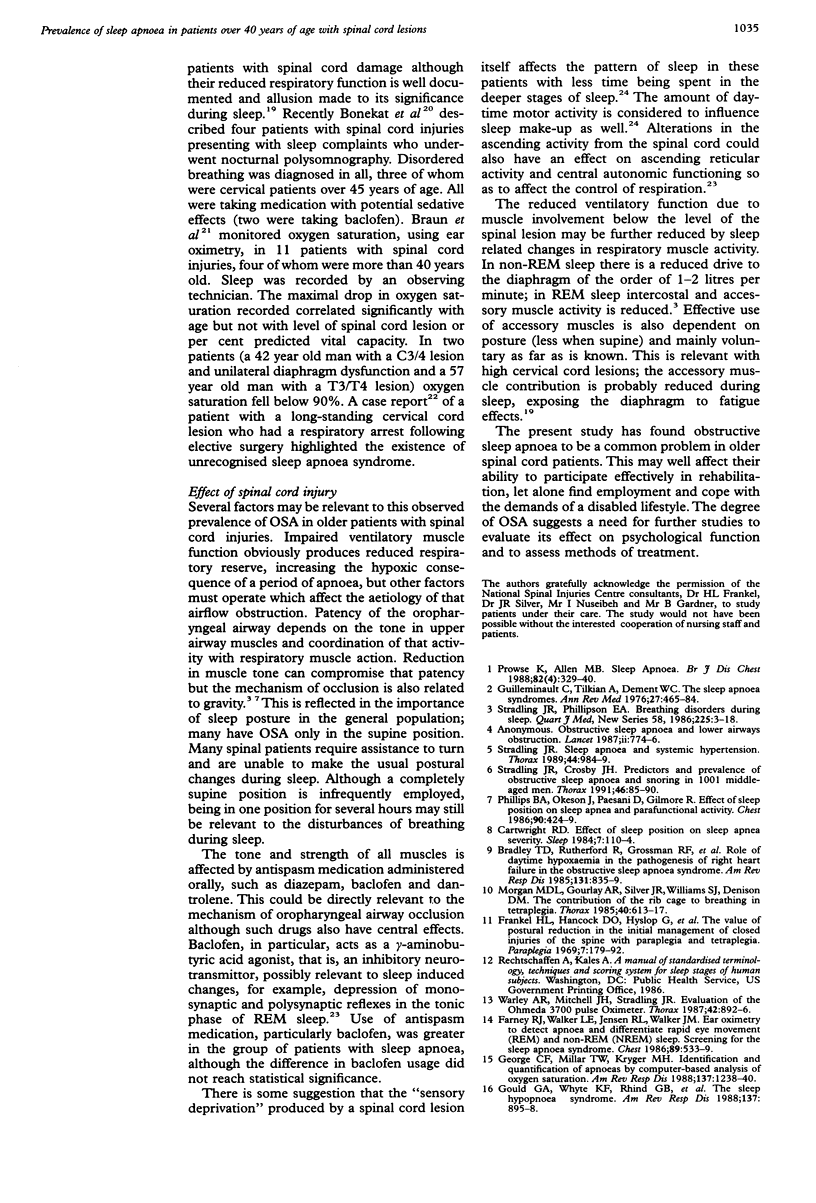
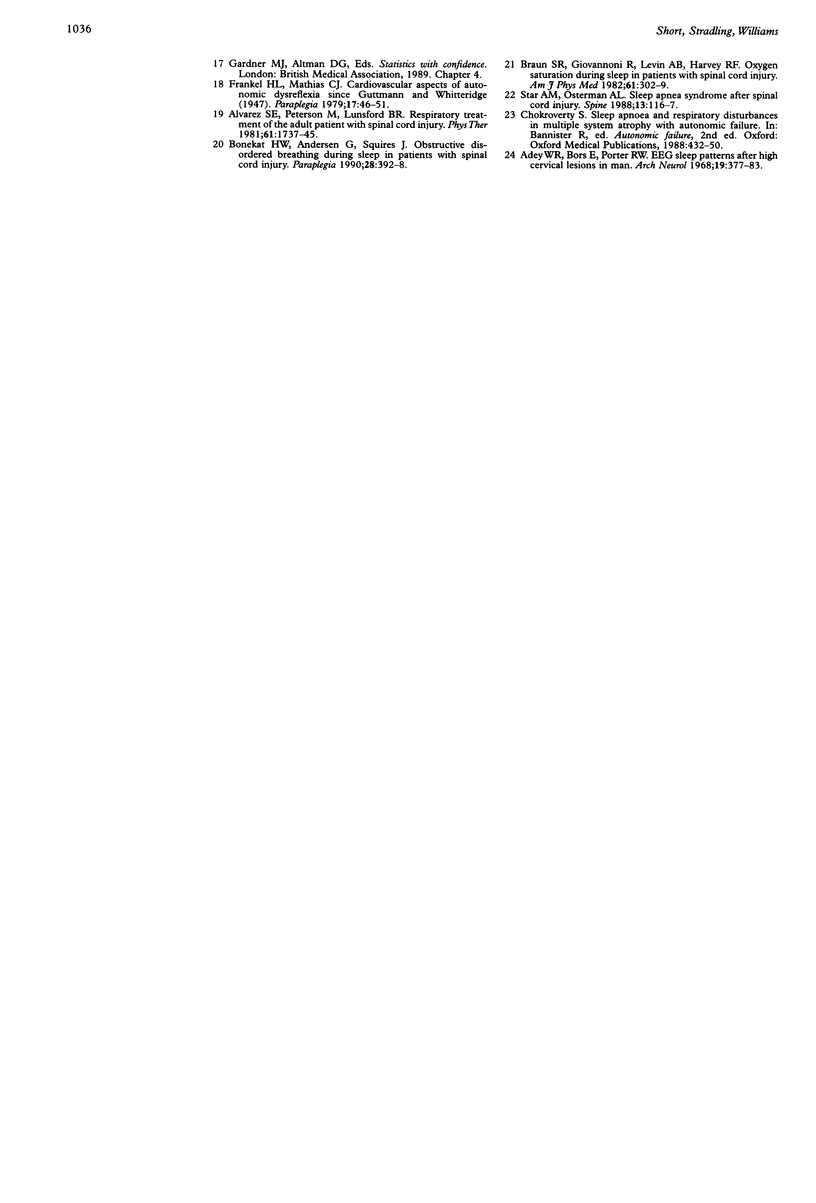
Selected References
These references are in PubMed. This may not be the complete list of references from this article.
- Adey W. R., Bors E., Porter R. W. EEG sleep patterns after high cervical lesions in man. Arch Neurol. 1968 Oct;19(4):377–383. doi: 10.1001/archneur.1968.00480040043003. [DOI] [PubMed] [Google Scholar]
- Alvarez S. E., Peterson M., Lunsford B. R. Respiratory treatment of the adult patient with spinal cord injury. Phys Ther. 1981 Dec;61(12):1737–1745. doi: 10.1093/ptj/61.12.1737. [DOI] [PubMed] [Google Scholar]
- Blickstein I., Schwartz-Shoham Z., Lancet M., Borenstein R. Vaginal delivery of the second twin in breech presentation. Obstet Gynecol. 1987 May;69(5):774–776. [PubMed] [Google Scholar]
- Bonekat H. W., Andersen G., Squires J. Obstructive disordered breathing during sleep in patients with spinal cord injury. Paraplegia. 1990 Jul;28(6):392–398. doi: 10.1038/sc.1990.52. [DOI] [PubMed] [Google Scholar]
- Bradley T. D., Rutherford R., Grossman R. F., Lue F., Zamel N., Moldofsky H., Phillipson E. A. Role of daytime hypoxemia in the pathogenesis of right heart failure in the obstructive sleep apnea syndrome. Am Rev Respir Dis. 1985 Jun;131(6):835–839. doi: 10.1164/arrd.1985.131.6.835. [DOI] [PubMed] [Google Scholar]
- Braun S. R., Giovannoni R., Levin A. B., Harvey R. F. Oxygen saturation during sleep in patients with spinal cord injury. Am J Phys Med. 1982 Dec;61(6):302–309. [PubMed] [Google Scholar]
- Cartwright R. D. Effect of sleep position on sleep apnea severity. Sleep. 1984;7(2):110–114. doi: 10.1093/sleep/7.2.110. [DOI] [PubMed] [Google Scholar]
- Farney R. J., Walker L. E., Jensen R. L., Walker J. M. Ear oximetry to detect apnea and differentiate rapid eye movement (REM) and non-REM (NREM) sleep. Screening for the sleep apnea syndrome. Chest. 1986 Apr;89(4):533–539. doi: 10.1378/chest.89.4.533. [DOI] [PubMed] [Google Scholar]
- Frankel H. L., Hancock D. O., Hyslop G., Melzak J., Michaelis L. S., Ungar G. H., Vernon J. D., Walsh J. J. The value of postural reduction in the initial management of closed injuries of the spine with paraplegia and tetraplegia. I. Paraplegia. 1969 Nov;7(3):179–192. doi: 10.1038/sc.1969.30. [DOI] [PubMed] [Google Scholar]
- Frankel H. L., Mathias C. J. Cardiovascular aspects of autonomic dysreflexia since Guttmann and Whitteridge (1947). Paraplegia. 1979 May;17(1):46–51. doi: 10.1038/sc.1979.12. [DOI] [PMC free article] [PubMed] [Google Scholar]
- George C. F., Millar T. W., Kryger M. H. Identification and quantification of apneas by computer-based analysis of oxygen saturation. Am Rev Respir Dis. 1988 May;137(5):1238–1240. doi: 10.1164/ajrccm/137.5.1238. [DOI] [PubMed] [Google Scholar]
- Gould G. A., Whyte K. F., Rhind G. B., Airlie M. A., Catterall J. R., Shapiro C. M., Douglas N. J. The sleep hypopnea syndrome. Am Rev Respir Dis. 1988 Apr;137(4):895–898. doi: 10.1164/ajrccm/137.4.895. [DOI] [PubMed] [Google Scholar]
- Guilleminault C., Tilkian A., Dement W. C. The sleep apnea syndromes. Annu Rev Med. 1976;27:465–484. doi: 10.1146/annurev.me.27.020176.002341. [DOI] [PubMed] [Google Scholar]
- Morgan M. D., Gourlay A. R., Silver J. R., Williams S. J., Denison D. M. Contribution of the rib cage to breathing in tetraplegia. Thorax. 1985 Aug;40(8):613–617. doi: 10.1136/thx.40.8.613. [DOI] [PMC free article] [PubMed] [Google Scholar]
- Phillips B. A., Okeson J., Paesani D., Gilmore R. Effect of sleep position on sleep apnea and parafunctional activity. Chest. 1986 Sep;90(3):424–429. doi: 10.1378/chest.90.3.424. [DOI] [PubMed] [Google Scholar]
- Prowse K., Allen M. B. Sleep apnoea. Br J Dis Chest. 1988 Oct;82(4):329–340. doi: 10.1016/0007-0971(88)90085-x. [DOI] [PubMed] [Google Scholar]
- Star A. M., Osterman A. L. Sleep apnea syndrome after spinal cord injury. Report of a case and literature review. Spine (Phila Pa 1976) 1988 Jan;13(1):116–117. doi: 10.1097/00007632-198801000-00029. [DOI] [PubMed] [Google Scholar]
- Stradling J. R., Crosby J. H. Predictors and prevalence of obstructive sleep apnoea and snoring in 1001 middle aged men. Thorax. 1991 Feb;46(2):85–90. doi: 10.1136/thx.46.2.85. [DOI] [PMC free article] [PubMed] [Google Scholar]
- Stradling J. R., Phillipson E. A. Breathing disorders during sleep. Q J Med. 1986 Jan;58(225):3–18. [PubMed] [Google Scholar]
- Stradling J. R. Sleep apnoea and systemic hypertension. Thorax. 1989 Dec;44(12):984–989. doi: 10.1136/thx.44.12.984. [DOI] [PMC free article] [PubMed] [Google Scholar]
- Warley A. R., Mitchell J. H., Stradling J. R. Evaluation of the Ohmeda 3700 pulse oximeter. Thorax. 1987 Nov;42(11):892–896. doi: 10.1136/thx.42.11.892. [DOI] [PMC free article] [PubMed] [Google Scholar]


